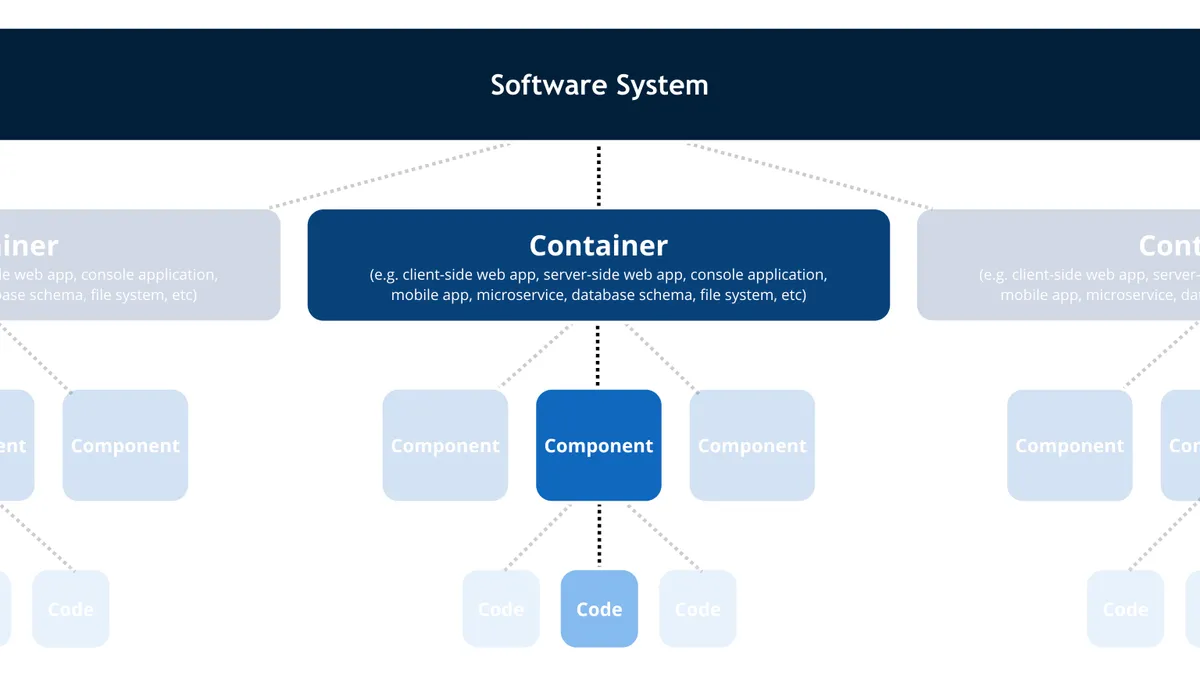C4 Model for Software Architecture

Definition
The C4 model is a software architecture modeling approach developed by Simon Brown. It is designed to help teams visualize and communicate software architecture effectively. The C4 model consists of hierarchical diagrams, each depicting a different level of abstraction.
Levels
The first level is the context diagram, which provides an overview of the system and its external actors, such as users, systems, and devices. The context diagram is followed by the container diagram, which shows the high-level components of the system and how they interact with each other.
The next level is the component diagram, which provides a detailed view of the internal components of each container. Finally, the code level is represented by the class diagram, which shows the detailed structure of individual components.
Benefits
One of the strengths of the C4 model is its focus on visualizing the architecture of the system in a way that is easy to understand. The diagrams are simple, clear, and easy to read, which makes them accessible to all stakeholders, regardless of their technical background. This makes it easier for teams to communicate the architecture of the system and to identify potential issues before they become problems.
Another benefit of the C4 model is that it encourages teams to think in terms of modularity and separation of concerns. By breaking down the system into smaller components and containers, teams can better manage complexity and make changes to the system without affecting other parts of the system.
Example
Let’s consider an example of a web-based e-commerce system to illustrate how the C4 model can be applied:
- Level 1 – Context Diagram: At this level, we show the system in its context. We identify the actors that interact with the system and external systems that the system needs to communicate with. In the case of the e-commerce system, external actors might include customers, suppliers, and shippers, and external systems might include payment gateways, shipping providers, and inventory management systems. The context diagram provides an overview of the system’s boundaries and its relationships with the outside world.
- Level 2 – Container Diagram: At this level, we decompose the system into high-level containers. Each container represents a logical grouping of components that work together to provide related capabilities. In the case of the e-commerce system, we might identify containers for the web application, the order management system, the payment gateway, and the shipping provider. We also show how the containers communicate with each other and external systems.
- Level 3 – Component Diagram: At this level, we dive deeper into the internals of each container and identify the key components and their relationships. For example, within the web application container, we might identify components for the shopping cart, product catalog, and customer profile. We also show the interfaces and protocols used by the components to communicate with each other and with external systems.
- Level 4 – Class Diagram: At this level, we provide a detailed view of the internal structure of each component. We might identify classes and their relationships, as well as interfaces, dependencies, and inheritance relationships. For example, within the shopping cart component, we might identify classes for the cart item, the cart itself, and the pricing rules.
Using the C4 model to describe the e-commerce system, we can communicate its architecture to stakeholders at different levels of abstraction, from high-level executives to developers. The C4 model provides a clear and consistent way to visualize the system’s architecture and helps ensure that all stakeholders have a shared understanding of the system’s design.
Conclusion
In conclusion, the C4 model is a valuable tool for software architects and development teams. It provides a clear and concise way to communicate the architecture of the system, which can lead to better collaboration and a more effective development process. By using the C4 model, teams can create more maintainable, scalable, and extensible systems that are easier to understand and modify over time.


